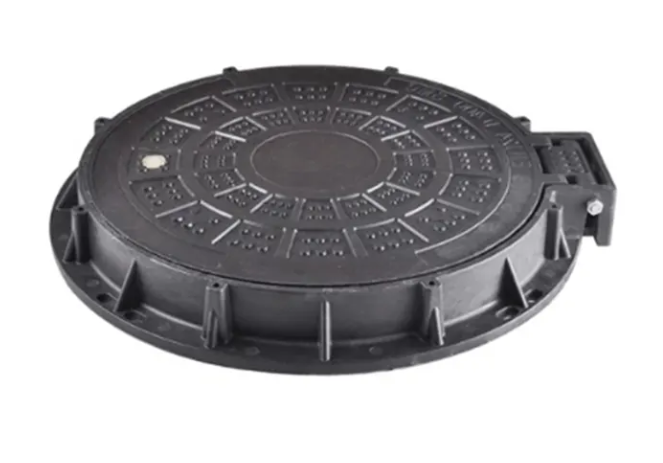Manhole covers are integral components of urban infrastructure, providing access to underground utilities such as sewers, storm drains, and electrical systems. Understanding their sizes, dimensions, materials, and load classifications is crucial for ensuring safety, durability, and compliance with local standards.

1. Standard Manhole Cover Sizes
Manhole covers come in various sizes to accommodate different applications and traffic loads. The most common shapes are circular, square, and rectangular.
1.1 Circular Manhole Covers
Circular covers are prevalent due to their uniform load distribution and ease of manufacture. Standard diameters include:
-
450 mm
-
600 mm
-
750 mm
-
900 mm
-
1200 mm
1.2 Square and Rectangular Manhole Covers
These shapes are often used in areas with limited space or where alignment with existing infrastructure is necessary. Common dimensions are:
-
300 mm x 300 mm
-
600 mm x 600 mm
-
750 mm x 750 mm
-
1000 mm x 1000 mm
-
1200 mm x 1200 mm
2. Materials Used in Manhole Covers
The material selection for manhole covers depends on factors like load requirements, environmental conditions, and cost considerations.
2.1 Cast Iron
Cast iron is widely used due to its strength and durability. It can withstand heavy loads and is resistant to corrosion.
2.2 Ductile Iron
Ductile iron offers enhanced strength and flexibility compared to cast iron, making it suitable for areas with high traffic loads.
2.3 Steel
Steel covers are lighter than iron and are often used in applications where weight is a concern.
2.4 Composite Materials
Composite covers, made from materials like fiberglass or polymer concrete, are gaining popularity due to their corrosion resistance and lighter weight.
3. Load Classifications
Manhole covers are classified based on their load-bearing capacity, ensuring they can withstand the traffic and environmental conditions of their installation site. The European standard BS EN 124:2015 provides the following classifications:
-
A15: Pedestrian areas
-
B125: Light traffic areas
-
C250: Carriageways and parking areas
-
D400: Heavy-duty carriageways
-
E600: Airports and ports
-
F900: Extreme load areas
4. Standards and Regulations
Adhering to established standards ensures the safety and reliability of manhole covers. Key standards include:
-
BS EN 124: European standard for load classifications and testing methods.
-
ASTM A536: Standard specification for ductile iron castings.
-
ISO 1083: International standard for spheroidal graphite cast iron.
5. Installation and Maintenance
Proper installation and regular maintenance are essential for the longevity and functionality of manhole covers.
5.1 Installation Guidelines
-
Ensure the frame is level and securely anchored.
-
Use appropriate lifting equipment to handle heavy covers.
-
Seal joints to prevent water ingress.
5.2 Maintenance Practices
-
Regularly inspect for signs of wear or damage.
-
Clean debris and ensure proper drainage.
-
Lubricate moving parts to prevent corrosion.
6. Comparison Table
| Material | Weight | Corrosion Resistance | Load Capacity | Cost |
|---|---|---|---|---|
| Cast Iron | High | Moderate | High | Low |
| Ductile Iron | Higher | High | Very High | Medium |
| Steel | Medium | Low | Medium | Medium |
| Composite | Low | Very High | Low to Medium | High |
7. Frequently Asked Questions (FAQs)
7.1 What is the standard size for a manhole cover?
The standard size varies depending on the application. Common sizes include 450 mm and 600 mm for circular covers, and 600 mm x 600 mm for square covers. However, sizes can range from 300 mm x 300 mm to 1200 mm x 1200 mm to accommodate different needs.
7.2How do I determine the appropriate load class for a manhole cover?
The appropriate load class depends on the expected traffic in the area. For example:
-
A15: Pedestrian areas
-
B125: Residential streets
-
C250: Parking lots
-
D400: Highways
-
E600: Airports
-
F900: Docks
Refer to standards such as EN 124 or ASTM C857 for detailed specifications.
7.3 What materials are best for manhole covers in coastal areas?
In coastal areas, where corrosion is a concern, materials like ductile iron with corrosion-resistant coatings or composite materials are recommended. These materials offer enhanced durability against harsh environmental conditions.
7.4 Can manhole covers be customized?
Yes, manhole covers can be customized in terms of size, shape, material, and load classification to meet specific requirements. Consult with manufacturers to discuss customization options.
7.5 How often should manhole covers be inspected?
Regular inspections are essential to ensure the safety and functionality of manhole covers. It is recommended to inspect them at least annually and more frequently in high-traffic areas.
7.6 What are the benefits of composite manhole covers?
Composite manhole covers offer several advantages, including lighter weight, corrosion resistance, and reduced noise levels. They are particularly suitable for areas with high corrosion potential or where weight is a concern.
7.7 What materials are commonly used for manhole covers?
Common materials include:
-
Cast Iron: Traditional material with good strength.
-
Ductile Iron: Offers improved strength and flexibility.
-
Composite Materials: Lightweight and corrosion-resistant.
-
Stainless Steel: Highly resistant to corrosion and ideal for harsh environments.
Conclusion
Understanding the various aspects of manhole cover sizes and dimensions is crucial for selecting the appropriate cover for specific applications. By considering factors such as material, load classification, and environmental conditions, one can ensure the safety, durability, and compliance of manhole covers in urban infrastructure.
Note: For a visual demonstration of manhole cover measurements and classifications, refer to the following video:
References:
- Manhole Cover – Wikipedia
- BS EN 124: Gully tops and manhole tops for vehicular and pedestrian areas – European Committee for Standardization (CEN)
- ASTM A536 – Standard Specification for Ductile Iron Castings – ASTM International
- ISO 1083: Spheroidal Graphite Cast Iron – International Organization for Standardization (ISO)
- AASHTO Load Classifications and Standards – American Association of State Highway and Transportation Officials

